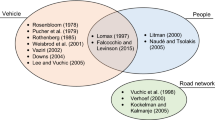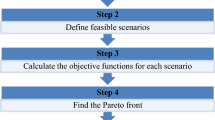Abstract
M/G/C/C analytical and simulation models have long been used to evaluate the performance of a large and complex topological network. However, such evaluation is only founded on a network’s total arrival rate and its weighted distance. Thus, this paper discusses some concepts and issues in building an M/G/C/C simulation model of a complex geometric system where all its arrival sources and their exact distances to the end of their networks (i.e., corridors) have been taken into consideration in measuring the impacts of various evacuation rates to its throughput, blocking probability, expected service time and expected number of pedestrians. For this purpose, the Dewan Tuanku Syed Putra hall, Universiti Sains Malaysia, Malaysia has been selected as a case study for various evaluations of complex pedestrian flows. These results were analyzed and compared with the results of our analytical and weighted distance simulation models. We then documented the ranges of arrival rates for each of the model where their results exhibited significant discrepancies and suggest ideal rates to best evacuate occupants from the hall. Our model can be utilized by policy makers to recommend suitable actions especially in emergency cases and be modified to build and measure the performance of other real-life complex systems.






Similar content being viewed by others
References
Altiok T, Melamed B (2007) Simulation modeling and analysis with ARENA. Academic, Burlington
Banks J, Carson JS, Nelson BL, Nicol DM (2010) Discrete-event system simulation, 5th edn. Pearson, New Jersey
Bedell P, Smith JM (2012) Topological arrangements of M/G/c/K, M/G/c/c queues in transportation and material handling systems. Comput Oper Res 39:2800–2819
Cassandras C, Lafortune S (1999) Introduction to discrete event systems. Kluwer Academic Publishers, Dordrecht
Cheah J, Smith JM (1994) Generalized M/G/C/C state dependent queueing models and pedestrian traffic flows. Queueing Syst 15:365–386
Concannon K, Elder M, Hunter K, Tremble J, Tse S (2007) Simulation modeling with SIMUL8. Visual Thinking International Ltd, Mississauga
Cruz FRB, Smith JM (2007) Approximate analysis of M/G/c/c state-dependent queueing networks. Comput Oper Res 34:2332–2344
Cruz FRB, Smith JM, Medeiros RO (2005) An M/G/C/C state dependent network simulation model. Comput Oper Res 32:919–941
Fruin JJ (1971) Pedestrian planning and design. Metropolitan Association of Urban Designers and Environmental Planners, New York
Glover F, Laguna M (1997) Tabu search. Kluwer, Boston
Hankin BD, Wright RA (1958) Passenger flow in subways. Oper Res Q 9:81–88
Holloway LE, Krogh BH, Giua A (1997) A survey of petri net methods for controlled discrete event systems. Discret Event Dyn Syst 7:151–190
Jain R, Smith JM (1997) Modeling vehicular traffic flow using M/G/C/C state dependent queueing models. Transp Sci 31:324–336
Kawsar LA, Ghani NA, Kamil AA, Mustafa A (2012) Restricted pedestrian flow performance measures during egress from a complex facility. World Acad Sci Eng Technol 67:399–404
Kelton WD (2009) Simulation with arena, 5th edn. McGraw-Hill, New York
Khalid R, Nawawi MKM, Kawsar LA, Ghani NA, Kamil AA, Mustafa A (2013) A discrete event simulation model for evaluating the performances of an M/G/C/C state dependent queuing system. PLoS ONE 8(4):e58402. doi:10.1371/journal.pone.0058402
Laguna M, Marti R (2003a) The OptQuest callable library. In: Voß S, Woodruff DL (eds) Optimization software class libraries. Kluwer Academic Publishers, New York, p 193--218
Laguna M, Marti R (2003b) Scatter search: methodology and implementations in C. Kluwer Academic Publisher, Boston
Mitchell DH, Smith JM (2001) Topological network design of pedestrian networks. Transp Res B Methodol 35:107–135
O’Flaherty CA, Parkinson MH (1972) Movement in a city centre footway. Traffic Engineering and Control 13:434--438
Piedrafita R, Villarroel JL (2011) Performance evaluation of petri nets centralized implementation. the execution time controller. Discret Event Dyn Syst 21:139–169
Rossetti MD (2010) Simulation modeling and arena. Wiley, New Jersey
Smith JM (2001) Evacuation networks. In: Floudas CA, Pardalos PM (eds) Encyclopedia of optimization. Kluwer Academic Publishers, Dordrecht, p 576--584
Smith JM (2011) Optimal routing in closed queueing networks with state dependent queues. INFOR Inf Syst Oper Res 49:45–62
Smith JM, Cruz FRB (2014) M/G/c/c state dependent travel time models and properties. Phys A Stat Mech Appl 395:560–579
Stepanov A, Smith JM (2009) Multi-objective evacuation routing in transportation networks. Eur J Oper Res 198:435–446
Strickland J (2011) Discrete event simulation using ExtendSim 8. Lulu Inc, Colarado
Wainer GA, Mosterman PJ (2010) Discrete-event modeling and simulation: theory and applications (computational analysis, synthesis, and design of dynamic systems). CRC Press, Boca Raton
Weiss A, Williams L, Smith JM (2012) Performance & optimization of M/G/c/c building evacuation networks. J Math Model Algoritm 11:361–386
Xia L (2014) Event-based optimization of admission control in open queueing networks. Discret Event Dyn Syst 24:133–151
Yao C, Cassandras C (2011) Perturbation analysis and optimization of multiclass multiobjective stochastic flow models. Discret Event Dyn Syst 21:219–256
Yuhaski SJ Jr, Smith JM (1989) Modeling circulation systems in buildings using state dependent queueing models. Queueing Syst 4:319–338
Acknowledgments
This study was supported by the Research University (RU) Grant Scheme, [account number 1001/PJJAUH/811097], Universiti Sains Malaysia. We wish to thank Universiti Sains Malaysia for the financial support. The funder had no role in study design, data collection and analysis, decision to publish, or preparation of the manuscript.
Author information
Authors and Affiliations
Corresponding author
Appendices
Appendix 1. The expected service time for source corridors

Appendix 2. The expected number of pedestrians for source corridors

Rights and permissions
About this article
Cite this article
Khalid, R., Nawawi, M.K.M., Kawsar, L.A. et al. The evaluation of pedestrians’ behavior using M/G/C/C analytical, weighted distance and real distance simulation models. Discrete Event Dyn Syst 26, 439–476 (2016). https://doi.org/10.1007/s10626-015-0215-0
Received:
Accepted:
Published:
Issue Date:
DOI: https://doi.org/10.1007/s10626-015-0215-0




